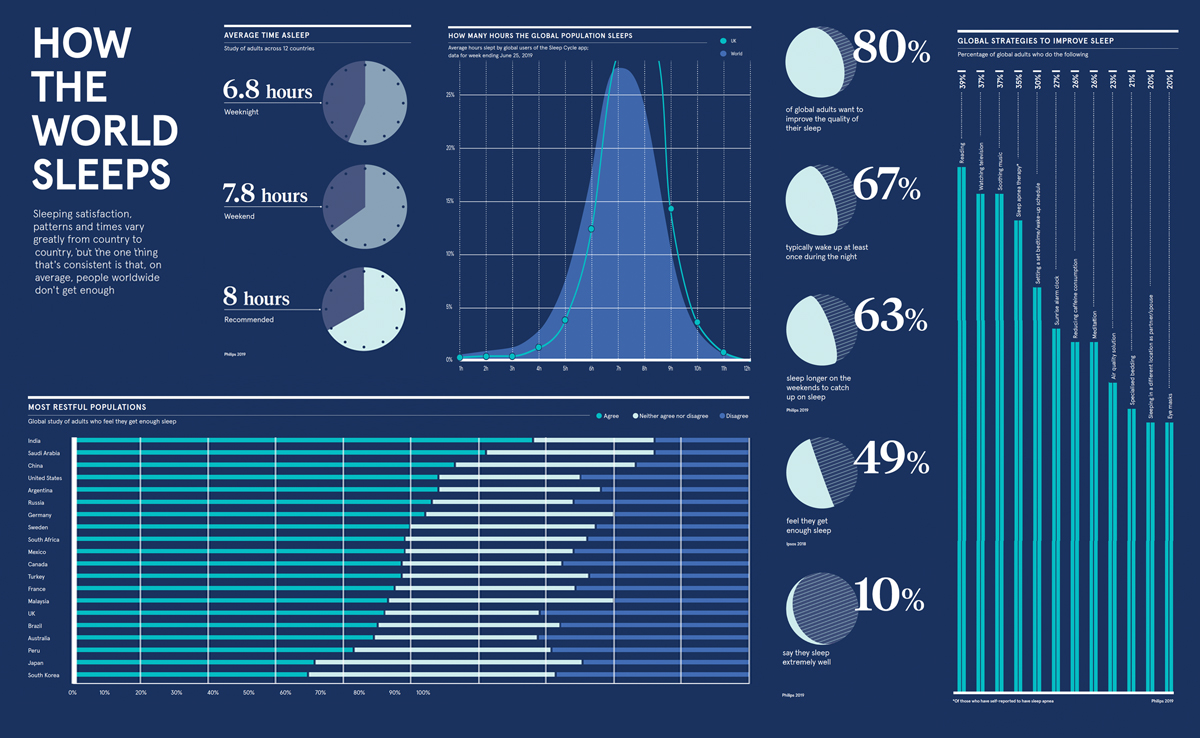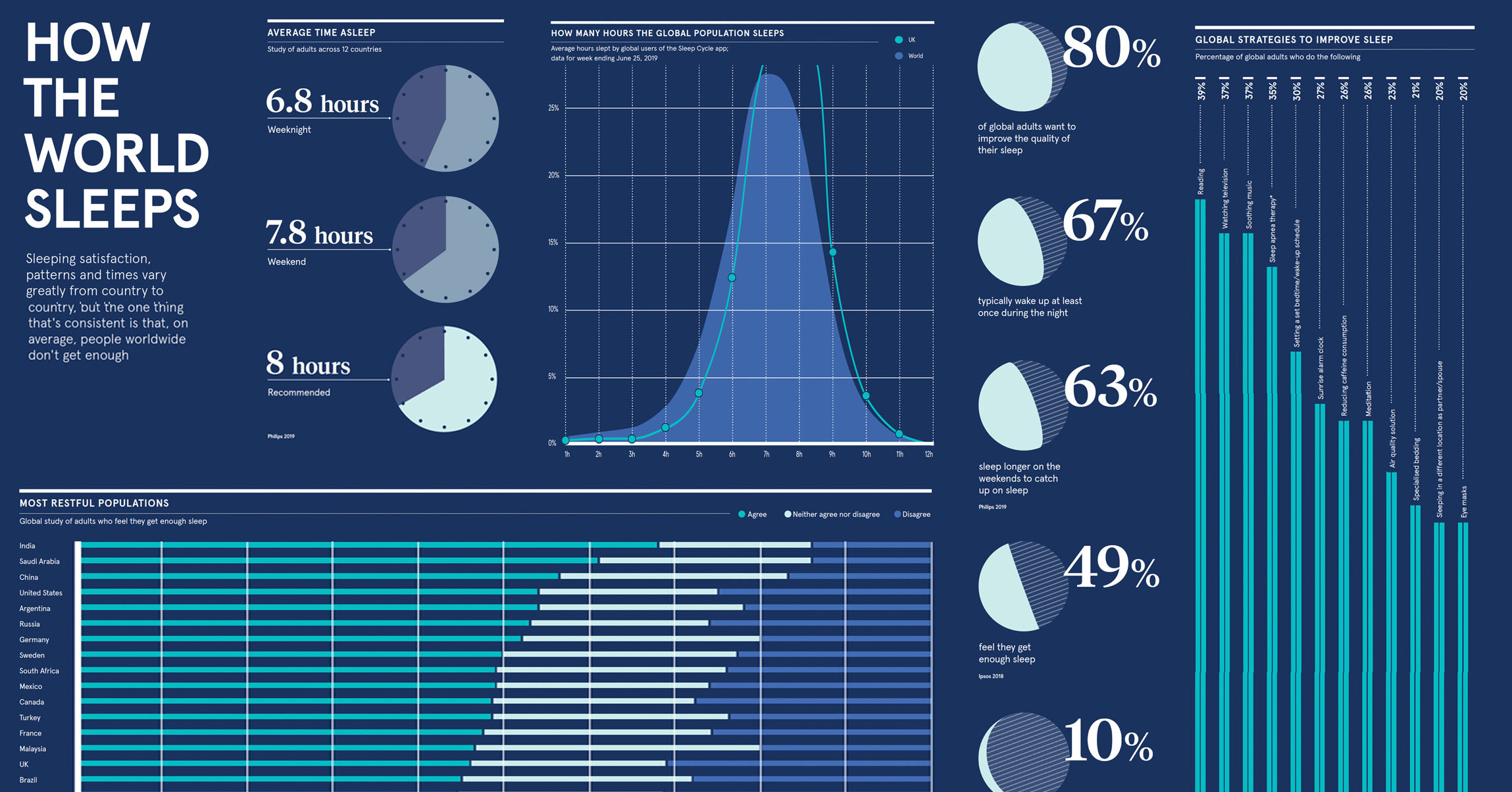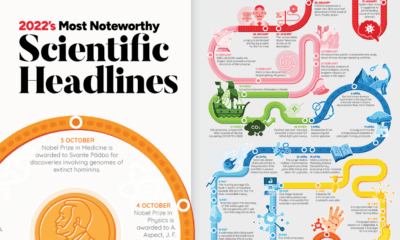Misc
Visualizing the World’s Sleeping Habits
View the full-resolution version of this infographic
Visualizing the World’s Sleeping Habits
Sleep quality, patterns, and duration may vary among countries, but one thing’s clear─people still aren’t getting enough sleep. While some people can function on a few hours, others find themselves reaching for that second cup of morning coffee instead of getting those extra Z’s.
Today’s graphic comes from Raconteur and highlights some startling takeaways from the 2019 Philips Global Sleep Survey, answered by over 11,000 adults from 12 countries.
Let’s settle in to discover what impacts our sleeping habits, also known as sleep hygiene, and what helps people sleep better and longer.
Why Sleep Is Important
Roughly 62% of adults worldwide feel that they don’t sleep well when they go to bed. Losing just one or two hours of sleep per night can have the same impact on motor and cognitive functions as going without sleep for a full day or two.
Experts have long emphasized that developing good sleeping habits can help to maintain our physical, mental, and emotional well-being. Ongoing sleep deprivation can also cause severe, long-term health conditions:
- Heart disease and heart failure
- Weak immune system
- High blood pressure
- Kidney disease
- Depression
- Diabetes
- Obesity
Drowsiness has been a significant factor in roughly 100,000 car accidents every year, causing an estimated 1,500 deaths. Sleep deficiency has also been linked to a number of disasters, such as airplane and boat accidents, and even nuclear reactor meltdowns.
The Science of Sleep
The human body follows the circadian rhythm─a 24-hour repeating rhythm that operates as an internal clock. This clock is controlled by two things: external cues such as light and darkness, and internal compounds that trigger and maintain our sleep.
These chemicals work together to keep our sleep/wake cycles in harmony.
- Adenosine: slowly builds the desire for sleep throughout the day
- Melatonin: produces drowsy feelings that signal your body is now ready for sleep
- Cortisol: naturally triggers your body to wake up
While sleep duration can vary greatly around the world, most adults are still not getting enough shut-eye. The average person gets 6.8 hours of sleep on a weeknight, which is significantly lower than the recommended 8 hours.
One company in the UK has even developed a real-time map of social media posts from people who say they can’t fall or stay asleep.
What Prevents Better Sleep?
People can suffer from a lack of sleep for many reasons─below are the top six culprits.
- Worry and Stress
Job, family, health, financial, and a myriad of other concerns plague people from all walks of life. Adults living in Canada and Singapore tend to be the most worried. - Environment
The physical space where you sleep plays a large role in the quality and duration of your sleep. Nearly 35% of adults fall asleep somewhere other than their bed. Interestingly, Chinese adults are the least comfortable when sleeping, while Japanese adults are the most comfortable. - Work and School Schedules
Hectic careers and heavy school workloads have a direct and lasting impact on sleeping habits. Many forego sleep in favor of completing work, social, and household responsibilities. - Entertainment
In the age of technology, natural rhythms of daytime and nighttime perception have been skewed, especially from the effects of blue light emitted from our device screens. - Disruptors
Eating food, or drinking alcohol or caffeine within the last few hours before bedtime can prevent our brains from knowing it’s time to wind down and get ready for sleep. Adults living in the fast-paced developed nations of China, Canada, the United States, and Singapore are the most caffeinated. - Health Conditions
Over three-quarters of adults experience at least one health condition that impacts sleep. These include insomnia, sleep apnea─which affects roughly 22 million people in the U.S. alone─snoring, restless leg syndrome (RLS), narcolepsy, and chronic pain.
Developing Good Sleeping Habits
Sleep is often the first to be neglected with our hectic schedules. Here are a few ways to practice better habits for a good night’s sleep.
Routine
Wake up and go to bed at the same time each day─even on weekends─to establish a more ingrained rhythm for your body clock and help your brain better prepare for sleep.
Exercise
Pick a time of day that suits your schedule and energy levels, and be sure to stick with it. Exercise helps to balance melatonin and cortisol levels throughout the day.
Light
Get outside often during the day and reduce the time spent outside at night. Limit screen time at least 30-60 minutes before sleep.
Food and Drink
Avoid eating large meals or drinking alcohol or caffeine in the last couple of hours before you go to sleep. Caffeine effects can linger for up to 8 hours, which breaks natural sleep rhythms.
Meditation
Recent studies have shown that mind-body treatments for insomnia such as yoga, tai chi, and meditation had positive impacts on improving sleep quality.
Comfort
Set the bed for success—keep your room cool and dark, buy a high-quality mattress and comfortable bed linens and use a white-noise machine to help you fall asleep.
Sleep is one of the most important aspects of our health; it’s also one of the easiest to neglect. Don’t put yourself into sleep debt─get enough shut-eye to enjoy those sweet dreams.
VC+
VC+: Get Our Key Takeaways From the IMF’s World Economic Outlook
A sneak preview of the exclusive VC+ Special Dispatch—your shortcut to understanding IMF’s World Economic Outlook report.

Have you read IMF’s latest World Economic Outlook yet? At a daunting 202 pages, we don’t blame you if it’s still on your to-do list.
But don’t worry, you don’t need to read the whole April release, because we’ve already done the hard work for you.
To save you time and effort, the Visual Capitalist team has compiled a visual analysis of everything you need to know from the report—and our VC+ Special Dispatch is available exclusively to VC+ members. All you need to do is log into the VC+ Archive.
If you’re not already subscribed to VC+, make sure you sign up now to access the full analysis of the IMF report, and more (we release similar deep dives every week).
For now, here’s what VC+ members get to see.
Your Shortcut to Understanding IMF’s World Economic Outlook
With long and short-term growth prospects declining for many countries around the world, this Special Dispatch offers a visual analysis of the key figures and takeaways from the IMF’s report including:
- The global decline in economic growth forecasts
- Real GDP growth and inflation forecasts for major nations in 2024
- When interest rate cuts will happen and interest rate forecasts
- How debt-to-GDP ratios have changed since 2000
- And much more!
Get the Full Breakdown in the Next VC+ Special Dispatch
VC+ members can access the full Special Dispatch by logging into the VC+ Archive, where you can also check out previous releases.
Make sure you join VC+ now to see exclusive charts and the full analysis of key takeaways from IMF’s World Economic Outlook.
Don’t miss out. Become a VC+ member today.
What You Get When You Become a VC+ Member
VC+ is Visual Capitalist’s premium subscription. As a member, you’ll get the following:
- Special Dispatches: Deep dive visual briefings on crucial reports and global trends
- Markets This Month: A snappy summary of the state of the markets and what to look out for
- The Trendline: Weekly curation of the best visualizations from across the globe
- Global Forecast Series: Our flagship annual report that covers everything you need to know related to the economy, markets, geopolitics, and the latest tech trends
- VC+ Archive: Hundreds of previously released VC+ briefings and reports that you’ve been missing out on, all in one dedicated hub
You can get all of the above, and more, by joining VC+ today.
-

 Debt1 week ago
Debt1 week agoHow Debt-to-GDP Ratios Have Changed Since 2000
-

 Markets2 weeks ago
Markets2 weeks agoRanked: The World’s Top Flight Routes, by Revenue
-

 Countries2 weeks ago
Countries2 weeks agoPopulation Projections: The World’s 6 Largest Countries in 2075
-

 Markets2 weeks ago
Markets2 weeks agoThe Top 10 States by Real GDP Growth in 2023
-

 Demographics2 weeks ago
Demographics2 weeks agoThe Smallest Gender Wage Gaps in OECD Countries
-

 United States2 weeks ago
United States2 weeks agoWhere U.S. Inflation Hit the Hardest in March 2024
-

 Green2 weeks ago
Green2 weeks agoTop Countries By Forest Growth Since 2001
-

 United States2 weeks ago
United States2 weeks agoRanked: The Largest U.S. Corporations by Number of Employees
















